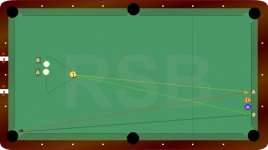Jaden said:Not in conjunction with follow and draw yet, JUST side spin. The best way to adjust for side spin is NOT instinct, it is BHE or aim and pivot. Find your cues pivot point, there are other threads on how to do this. Or find a cue or shaft that has a pivot point that is where you like to have your bridge.
I know we are discussing theory here and there are no absolutes, but I absolutely disagree with this advice.
You are breaking a fundamental rule and that being, changing your cue arm and body alignment after you set up. you are removing your references for body/arm position.
You will never achieve consistency with this style.
You should have made your decision of how to play the shot before you set your forward foot down, that forward foot should be pointing in the direction of the intended cue ball travel. Your body and arms alignment should be set and not altered, if you find your in the wrong position you should get back up and start again.
Changing the position of your swinging arm after you get down will cause you to be inconsistent and open to many variables in the way you swing the cue through. You will find it difficult to consistently deliver the cue through straight.
Last edited:
